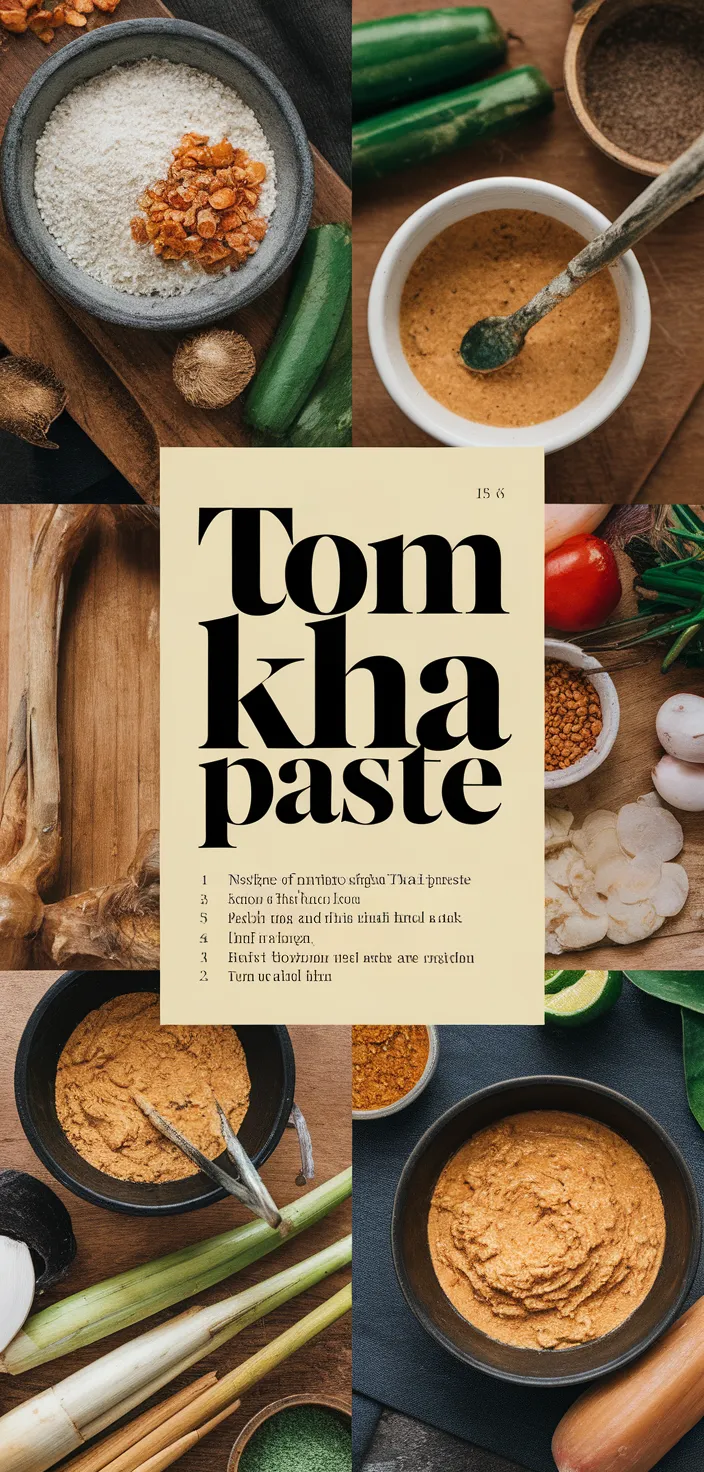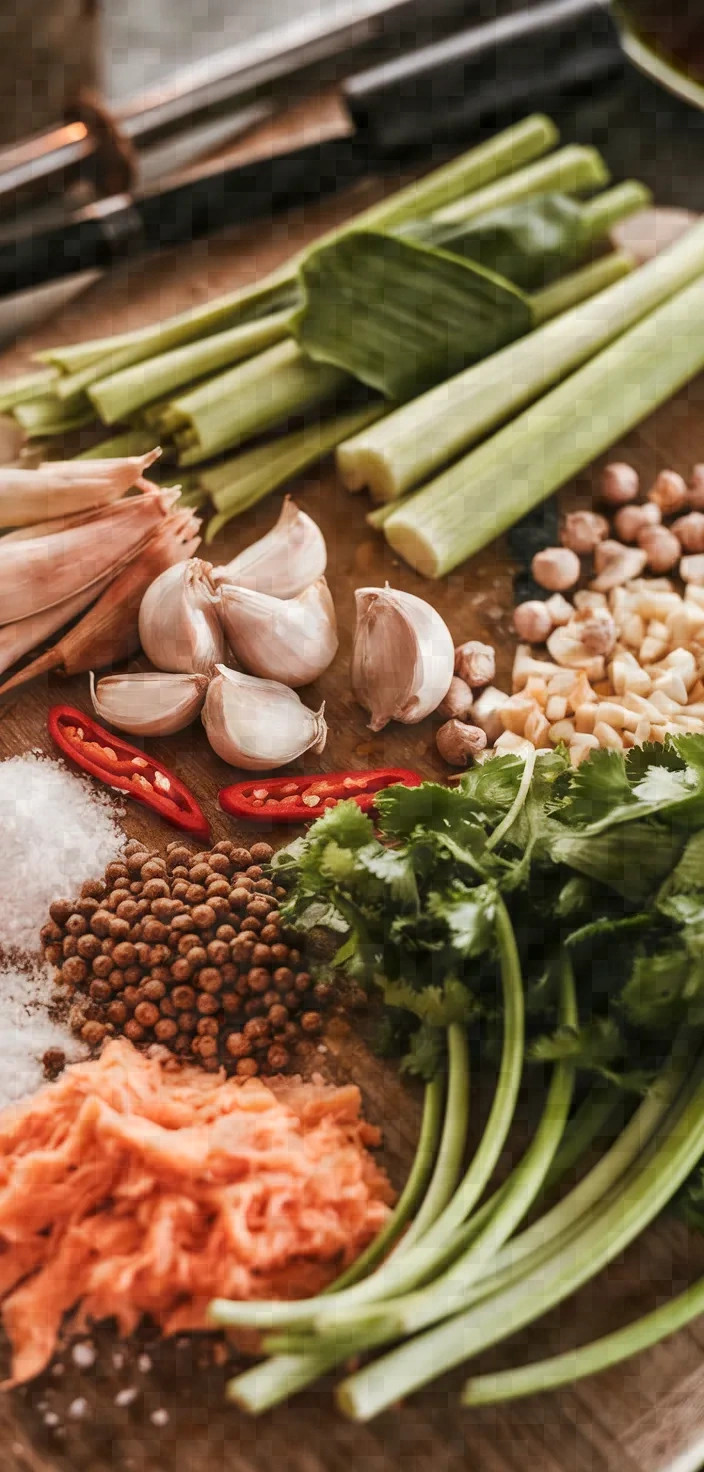I absolutely love this recipe because it takes me on a flavor-packed journey straight to the vibrant streets of Thailand, right from my cozy kitchen. Plus, the process of pounding all those aromatic ingredients together feels like culinary therapy, leaving my kitchen smelling like a dream!

I enjoy crafting a multiuse base such like Tom Kha Paste, which lets you incorporate the deliciousness of Thai cuisine into any dish. Two tablespoons of sliced galangal paired with the zest of four to five torn kaffir lime leaves give this a wonderful aroma.
The heat from five to six red bird’s eye chilies complements the citrusy notes of lemongrass beautifully.
Ingredients

Galangal:
Contributes a spicy, peppery flavor; assists with digestions and has anti-inflammatory properties.
Kaffir Lime Leaves:
Conveys an aromatic, citrusy scent; plentiful in antioxidants.
Lemongrass:
Offers a renewed, citrusy flavor; helps with digestive issues and is germicidal.
Bird’s Eye Chilies:
Imparts warmth and piquancy; abundant in vitamin C, stimulates metabolism.
Shrimp Paste:
Adds an umami depth; is also a protein- and nutrient-dense food.
Palm Sugar:
Imparts sweetness; raw, offering a wealth of trace minerals.
Ingredient Quantities
- 2 tablespoons galangal, sliced
- 4-5 kaffir lime leaves, torn
- 2 stalks lemongrass, finely chopped
- 5-6 small shallots, peeled
- 5 cloves garlic
- 5-6 red bird’s eye chilies
- 3-4 tablespoons cilantro roots and stems, chopped
- 2 tablespoons shrimp paste
- 1 teaspoon white peppercorns
- 1 teaspoon salt
- 1 tablespoon palm sugar
- 1 tablespoon fish sauce
- 1 tablespoon lime juice
- 2 tablespoons vegetable oil
Instructions
1. Start by getting the ingredients ready: galangal sliced, kaffir lime leaves torn, lemongrass chopped fine, and shallots and garlic peeled and ready for the chopping end of the food processor. The food processor is essential if you are going to make a lot of this broth. If you’re not serving a small army, halve the recipe, and remember to reduce the amount of time you’ll be cooking the broth. Most Thai cooks use a food processor.
2. Using a mortar and pestle, combine the salt and white peppercorns, and grind them into a fine powder.
3. Using a mortar and pestle, pound together coarsely chopped lemongrass, galangal, garlic, shallots, and chiles to form a chunky paste.
4. The mortar is filled with cilantro roots and stems along with the shrimp paste. They are pounded in the mortar until a smooth paste is formed.
5. In a saucepan set over medium heat, add the vegetable oil.
6. Add the paste you have prepared to the pan and sauté it gently for about 3 to 5 minutes. Let the flavors meld and become fragrant.
7. Add the torn kaffir lime leaves and cook for another minute. Do this to allow their deliciousness to permeate the dish.
8. Incorporate the palm sugar, fish sauce, and lime juice into the paste, stirring them well together to ensure that the sugar is completely dissolved.
9. Maintain a low heat and keep stirring the paste for another 2-3 minutes. You want to make sure that all of the ingredients are well mixed and that the paste has a uniform consistency from beginning to end.
10. Tom Kha paste can be stored in an airtight container for up to one week in the fridge. Use it as a base for soups or curries; allow it to cool slightly first, and then seal it up tightly.
Equipment Needed
1. Food processor
2. Mortar and pestle
3. Saucepan
4. Chopping board
5. Knife
6. Measuring spoons
7. Airtight container
FAQ
- What is Tom Kha Paste used for?The basis for creating the Tom Kha soup is this paste, a potent and fragrant blend of Thai spices. The Tom Kha soup itself is a classic coconut soup, typically made with chicken or seafood, that is creamy, savory, and aromatic.
- Can I substitute any ingredients if I can’t find them?Should galangal be unobtainable, ginger makes a fine substitute, though it changes the flavor somewhat. You can use lime zest in place of kaffir lime leaves.
- How long can I store the Tom Kha Paste?An airtight container in the refrigerator can hold it for up to a week, or, for longer storage, pop it in the freezer, where it’ll be good for three months.
- What is the level of spiciness for this paste?The paste has a moderate level of heat from the bird’s eye chilies. If you prefer less heat, you can adjust it by using fewer chilies.
- Can I make this paste vegetarian?To create a vegetarian version, do not use shrimp paste and fish sauce. Instead, use a mixture of salt and soy sauce to simulate the umami flavor.
- Why is oil included in the ingredients?The ingredients are combined into a smooth paste; the vegetable oil plays a crucial role in this task and our task. As with any of our recipes, we want to preserve the flavors of our ingredients, and the oil does a very good job of that.
This is why we use vegetable oil to help combine into a smooth paste and to preserve the flavors of our ingredients.
- Is it essential to use cilantro roots?The paste has a distinctive flavor that comes from using the roots, but if you can’t find the roots, you can use the stems. The roots are harder to find and more aromatic, but the stems work just fine if you’re looking to make the paste.
Substitutions and Variations
Should you not have access to galangal, you may replace it with fresh ginger, although this will change the flavor somewhat.
Kaffir lime leaves can be replaced with a mixture of lime zest and a small bay leaf.
You can substitute lemon zest and a splash of lemon juice for lemongrass to replicate its citrusy notes.
If finding cilantro roots proves difficult, use the stems and leaves, or parsley roots as a substitute.
You can use brown sugar or light muscovado sugar, which have a similar caramel flavor profile, instead of palm sugar.
Pro Tips
1. Toast the Spices Before grinding the white peppercorns and salt, lightly toast the peppercorns in a dry pan for a few minutes. This will enhance their aroma and flavor, giving your paste a deeper nuance.
2. Fresh Ingredients For the best flavor, use the freshest ingredients possible, especially the herbs and chilies. Fresh cilantro roots, kaffir lime leaves, and lemongrass will have more vibrant and authentic flavors essential for traditional Thai dishes.
3. Balancing Flavors Adjust the balance of salty, sweet, sour, and spicy according to your taste before finishing the paste. If you prefer more heat, add extra bird’s eye chilies. For more sourness, increase the lime juice. Tailor it to your palette.
4. Storage If you want to store the paste for longer than a week, consider freezing it in ice cube trays. This way, you can use smaller portions as needed and maintain freshness over time.
5. Enhance with Umami For an additional umami kick, you can add a small amount of fish sauce or even a splash of soy sauce when you’re sautéing the paste, depending on your preference. Be cautious with the salt levels if you do so.

Tom Kha Paste Recipe
My favorite Tom Kha Paste Recipe
Equipment Needed:
1. Food processor
2. Mortar and pestle
3. Saucepan
4. Chopping board
5. Knife
6. Measuring spoons
7. Airtight container
Ingredients:
- 2 tablespoons galangal, sliced
- 4-5 kaffir lime leaves, torn
- 2 stalks lemongrass, finely chopped
- 5-6 small shallots, peeled
- 5 cloves garlic
- 5-6 red bird’s eye chilies
- 3-4 tablespoons cilantro roots and stems, chopped
- 2 tablespoons shrimp paste
- 1 teaspoon white peppercorns
- 1 teaspoon salt
- 1 tablespoon palm sugar
- 1 tablespoon fish sauce
- 1 tablespoon lime juice
- 2 tablespoons vegetable oil
Instructions:
1. Start by getting the ingredients ready: galangal sliced, kaffir lime leaves torn, lemongrass chopped fine, and shallots and garlic peeled and ready for the chopping end of the food processor. The food processor is essential if you are going to make a lot of this broth. If you’re not serving a small army, halve the recipe, and remember to reduce the amount of time you’ll be cooking the broth. Most Thai cooks use a food processor.
2. Using a mortar and pestle, combine the salt and white peppercorns, and grind them into a fine powder.
3. Using a mortar and pestle, pound together coarsely chopped lemongrass, galangal, garlic, shallots, and chiles to form a chunky paste.
4. The mortar is filled with cilantro roots and stems along with the shrimp paste. They are pounded in the mortar until a smooth paste is formed.
5. In a saucepan set over medium heat, add the vegetable oil.
6. Add the paste you have prepared to the pan and sauté it gently for about 3 to 5 minutes. Let the flavors meld and become fragrant.
7. Add the torn kaffir lime leaves and cook for another minute. Do this to allow their deliciousness to permeate the dish.
8. Incorporate the palm sugar, fish sauce, and lime juice into the paste, stirring them well together to ensure that the sugar is completely dissolved.
9. Maintain a low heat and keep stirring the paste for another 2-3 minutes. You want to make sure that all of the ingredients are well mixed and that the paste has a uniform consistency from beginning to end.
10. Tom Kha paste can be stored in an airtight container for up to one week in the fridge. Use it as a base for soups or curries; allow it to cool slightly first, and then seal it up tightly.
